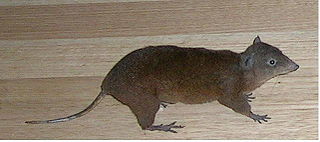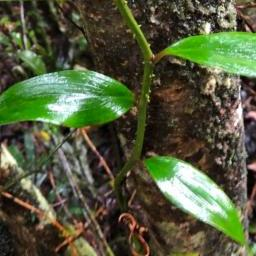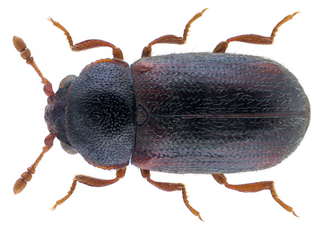
The lagomorphs are the members of the taxonomic order Lagomorpha, of which there are two living families: the Leporidae and the Ochotonidae (pikas). There are 110 recent species of lagomorph of which 109 are extant, including 10 genera of rabbits, 1 genus of hare and 1 genus of pika. The name of the order is derived from the Ancient Greek lagos + morphē.

Eutheria, also called Pan-Placentalia, is the clade consisting of placental mammals and all therian mammals that are more closely related to placentals than to marsupials.

The Nitrosomonadales are an order of the class Betaproteobacteria in the phylum Pseudomonadota. Like all members of their class, they are Gram-negative.

The Hypsiprymnodontidae are a family of macropods, one of two families containing animals commonly referred to as rat-kangaroos. The single known extant genus and species in this family, the musky rat-kangaroo, Hypsiprymnodon moschatus, occurs in northern Australia. During the Pleistocene, this family included the megafauna genus Propleopus.
Armintomys is an extinct genus of rodent from North America related to jerboas and jumping mice. It is the only genus in the family Armintomyidae. It lived during the early Eocene, and is the oldest known example of a hystricomorphous zygomasseteric dentition. In addition, Armintomys is also the oldest known rodent that had an incisor enamel transition from pauciserial to uniserial. Its remains have only been found in the Wind River Basin in Wyoming, and could be found there during the species' existence on Earth. It was previously assumed that Armintomys belonged to the Dipodoidea family, but has since been understood to have been part of an early radiation of dipodoid rodents, but was not directly ancestral to any later dipodoids, thus it was recategorized into its own family.

The brushtail possums are the members of the genus Trichosurus in the Phalangeridae, a family of marsupials. They are native to Australia and some small nearby islands. Unique among marsupials, they have shifted the hypaxial muscles from the epipubic to the pelvis, much like in placental mammals, meaning that their breathing cycle is more similar to the latter than to that of other non-eutherian mammals. In general, they are more terrestrially oriented than other possums, and in some ways might parallel primates.

Atelerix is a genus of hedgehog in the family Erinaceidae. It contains four species, all native to Africa.
Dipnorhynchidae is an extinct family of prehistoric lungfishes which lived during the Devonian period.

Eels are ray-finned fish belonging to the order Anguilliformes, which consists of eight suborders, 20 families, 164 genera, and about 1000 species. Eels undergo considerable development from the early larval stage to the eventual adult stage and are usually predators.
Stoschiosaurus is an extinct genus of trematosaurian temnospondyl within the family Trematosauridae. It lived during the Early Triassic in what is now Greenland. Fossils were found in the Wordie Creek Formation.

Stenotosaurus is an extinct genus of capitosaurian temnospondyl within the family Stenotosauridae. It is known from three species, all of which lived during the Anisian stage of the Middle Triassic. Fossils have been found in England and Germany.
Rhynchodipteridae is a family of prehistoric lungfishes which lived during the Devonian period.

Petermannia is the sole genus of plants in the family Petermanniaceae. Petermannia cirrosa, the only species in the genus, is endemic to the states of New South Wales and Queensland in Australia. it is a prickly, wiry stemmed vine which grows to 6 metres in height and has lancelote, ovate or elliptic leaves with an acute apex. The flowers, which appear during summer, have reflexed reddish green or white tepals. These are followed by rounded red berries.

Sphindidae is a family of beetles, in the suborder Polyphaga. They are called slime mold beetles due to their exclusive feeding on slime molds during adult and larval stages, other aspects of their life history are obscure. Palaeontological discoveries since 2015 have added to the geologic history of Sphindidae, including the discovery of Libanopsis, placed in the extinct subfamily Libanopsinae.
Kurmademys is an extinct genus of side-necked turtle which existed in India during the late Cretaceous period. It was first named in 2001, by Eugene S. Gaffney, Sankar Chatterjee, and Dhiraj K. Rudra, and contains the species Kurmademys kallamedensis. The species name is derived from the Kallamedu Formation of southern India, where the type specimen of the genus was discovered. It was assigned to the family Bothremydidae.
Fusionidae is a family of the superfamily Fusionicae in the phylum Apicomplexa
Schizocystidae is a genus of parasitic alveolates in the phylum Apicomplexa.
Yingvirus is a genus of negative-strand RNA viruses which infect invertebrates. Member viruses have bisegmented genomes. It is the only genus in the family Qinviridae, which is the only family in Muvirales, which is the only order in Chunqiuviricetes. There are eight species in the genus.
Johnbell is an extinct genus of ungulates in the family Interatheriidae. The only known species belonging to the genus is Johnbell hatcheri. This animal was named after American paleontologist John Bell Hatcher. This genus is related to Ignigena and the subfamily Interatheriinae. This animal lived in central Chile during the Early Oligocene.















